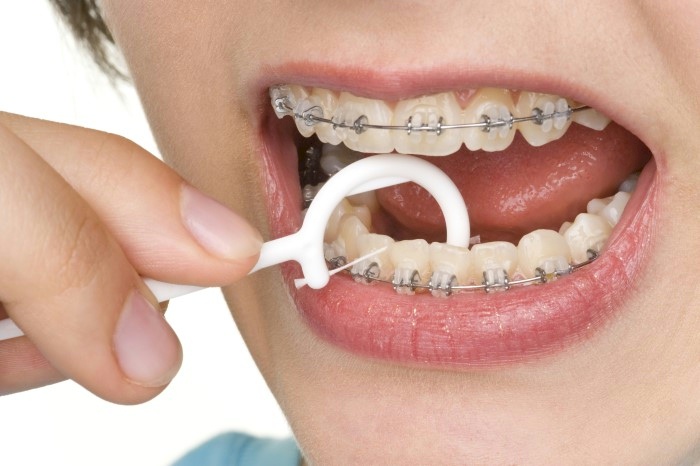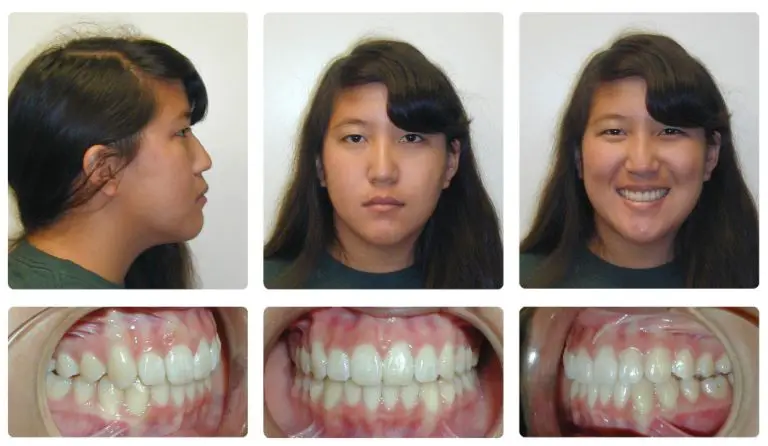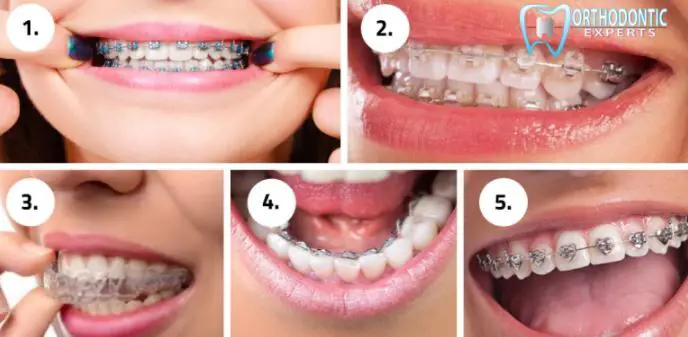Last Updated on 2 weeks by Dr. Michelle G. Brito
Flossing with braces can be difficult and time-consuming, but it is essential to do it properly to avoid tooth decay and gum disease. Here are some tips:
1. Use a floss threader to thread the floss under the wires of your braces.
2. Wrap the floss around each tooth, using a back-and-forth motion, and make sure to get under the gumline.
3. Be gentle when flossing so you don’t damage your gums or dislodge your brackets.
4. Rinse your mouth with water after flossing to remove any food particles or plaque that may have been loosened during the process.
- Take a piece of floss and wet it, then wind the majority of it around your index finger.
- Grip the floss firmly using the index fingers and thumbs of both hands.
- Guide the floss under your wire using a gentle back-and-forth motion.
- Once the floss gets to your gum line, create a curved C-shape around a single tooth.
- Gently slide the floss up and down against the side of that tooth, being careful not to put too much pressure on your gums.
- Floss under any other wires connecting your teeth before moving to another tooth surface

Credit: www.iorthosd.com
Can You Use Regular Floss With Braces?
If you have braces, you may be wondering if you can still use regular floss or if you need to get a particular kind. The good news is that you can continue to use the same type of floss that you used before getting braces. The important thing is to be careful and take your time so that you don’t damage your braces.
To floss with braces, start by threading the floss under the primary wire in front of one of your back teeth. Gently move the floss up and down against each tooth, using a light back-and-forth motion. When you get to the gum line, curve the floss around the tooth and clean it along the gum line.
Be sure to thread the floss under the wire again before moving on to another tooth. It’s important to be gentle when cleaning around brackets and wires because they can quickly become damaged or dislodged. If you’re not careful, you could also end up cutting yourself on sharp edges.
With a bit of practice, though, flossing with braces will become second nature!
What are some tips to make flossing less challenging for someone who wears braces?
With braces, flossing is a challenge. But it’s essential to floss every day to remove plaque and food debris from your teeth and gums. Follow these tips:
1. Use an orthodontic floss threader. This tool will help you get the floss under your wire without having to remove your braces.
2. Wrap the floss around your index finger and glide it up and down each tooth. Be sure to go under the wire on each tooth as well.
3. Use a water pick or oral irrigator to clean hard-to-reach areas around your braces.
4. Ask your orthodontist about interdental brushes, which are tiny brushes that fit between teeth and help clean around brackets and wires.
5. Be patient! It may take a little time to get used to flossing with braces, but once you get the hang of it, it will become second nature in no time!
Is it OK not to floss with braces?
It’s OK to not floss with braces as long as you’re careful about other oral hygiene habits. Without flossing, plaque and bacteria can build up around the gum line and between teeth. It can lead to gingivitis, cavities, and bad breath.
So be sure to brush twice a day, use mouthwash, and visit your dentist regularly.
How to Floss with Braces
How to Floss With Braces With Threader
If you have braces, you know that Flossing can be a bit more challenging than usual. But it’s essential to floss every day to remove plaque and food particles from your teeth and gums and to help keep your smile healthy. One way to make Flossing with braces easier is to use a floss threader.
The loop goes over the wire of your braces, and the other end of the threader holds the dental floss. To use a floss threader:
Wet the end of the threader and insert it under the wire of your top front teeth.
Guide the threader up and down along each side of your tooth until it comes out through the space between your gum and tooth.
Gently guide the dental floss through the loop on the threader until it comes out on the other side.
Use a back-and-forth motion to clean between each tooth before moving on to another area.
When you’re done, carefully remove the dental floss from your mouth so that you don’t accidentally pull off a bracket or wire.
How to Floss With Braces Without Threader
If you have braces, Flossing can be a challenge. But it’s essential to floss every day to remove plaque and bacteria from your teeth and gums. Luckily, there are a few ways you can floss with braces without using a threader.
Here are some tips:
1. Use an interdental brush. These brushes are small and come in different sizes to fit between your teeth. They’re great for getting into those hard-to-reach places.
2. Try floss picks. These picks have a small piece of floss at the end that’s perfect for getting under your wire. Insert the pick between your teeth and use the floss to clean around your braces.
3 . Use regular dental floss. You can still use regular dental floss with braces. You need to be careful not to snap the floss against your wires. Instead, gently guide the dental floss under your wires and between your teeth. Be sure to use a fresh section of dental floss for each tooth so you don’t re-introduce any plaque or bacteria.
4 . Remember water picking! Water picking is an effective way to clean around braces and remove plaque. Fill up the reservoir on the water pick with warm water, point the tip toward your gum line, and press the button. The water will jet out and help loosen any plaque or food particles caught around your braces.
5 Finally, make sure you see your orthodontist regularly! They’ll be able to check that your brushing and posing routine is effective and make any necessary adjustments to ensure you keep those pearly whites healthy while you have braces!
How to Floss Back Teeth With Braces
If you have braces, you know that Flossing can be a bit more challenging than usual. But it’s still essential to clean all surfaces of your teeth, including the backs of your back teeth (molars). Here’s a step-by-step guide to flossing with braces:
1. Measure and slice a length of floss that is approximately 18 inches. You’ll need a longer piece than usual so that you can quickly wrap it around your fingers and reach all areas of your mouth.
2. Wrap one end of the floss around your middle finger on one hand and hold the other end with the index finger on your other hand.
3. Gently insert the floss between two teeth, using a back-and-forth motion. Be careful not to snap the floss into place, as this could damage your gums or brackets.
4. Use a gentle sawing motion to move the floss up and down against each tooth surface until you’ve reached the gum line.
Remember to get underneath any wires!
5. Unwind the floss from around your fingers and repeat these steps for each tooth in your mouth, being sure to use a fresh section of floss for each tooth surface.
What Happens If You Don’t Floss With Braces
If you don’t floss with braces, plaque and bacteria can build up around your teeth and gums. This can lead to gum disease, tooth decay, and bad breath. Additionally, the wires and brackets of your braces can trap food particles, which can also lead to decay and other problems.
Therefore, it’s essential to floss daily, even if you have braces.
How to Floss With Braces Platypus
Assuming you would like a blog post discussing how to floss with braces, It’s essential to keep your teeth and gums healthy even if you have braces, and one way to do this is by flossing regularly. Here are some tips:
– Use an orthodontic flosser. This is a type of flosser that has a small handle and a U-shaped piece of wire at the end. The wire helps you get the floss under your braces and between your teeth.
– If you don’t have an orthodontic flosser, you can use regular dental floss. Just be sure to be extra careful not to damage your brackets or wires when maneuvering the floss around them.
– Use waxed dental floss. This type of floss is less likely to get caught on your braces or tear as you’re using it.
– Be gentle when Flossing. Gently guide the dental floss between each tooth, being careful not to snap it against your gums or pull too hard on your teeth/braces.
Best Floss for Braces
It’s essential to floss every day to remove plaque and bacteria from your teeth and gums. So, what’s the best type of floss for braces?
The good news is that there are now many types of floss designed explicitly for people with braces. One popular option is super floss, which has a stiff end that helps thread the floss under the wire of your braces. Another option is waxed floss, which slides more easily between teeth.
Whichever type of floss you choose, be sure to use gentle strokes and avoid jerking or snapping the floss against your gums. And remember to brush your teeth thoroughly twice a day!





